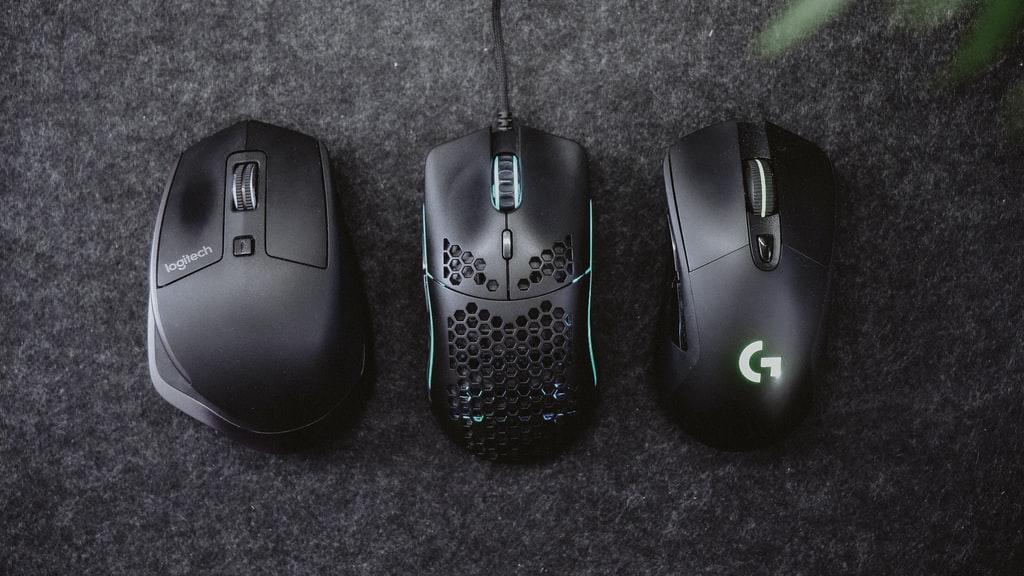Gaming Mouse with or without Cable – Which is Better?
Is a wired or wireless gaming mouse better? A few years ago, no question wired mice were better than wireless mice for gaming. High latency and other connectivity issues broke wireless mice. But how do things look now?
Nowadays, there is hardly any difference between wired and wireless gaming mice in terms of performance and latency. The choice of a wired or wireless gaming mouse is more of a budget question and depends on your preferences.
Many e-sports pros already use wireless gaming mice (for example, in CS:GO, Valorant, or League of Legends) but some still believe that they can’t compete with the wired versions. This misconception will likely be cleared up once wireless mice gain acceptance in competitive gaming scenes and become the standard.

So despite the nearly identical performance of wired and wireless mice, the question of the best choice for gaming remains. Therefore, we’ll show you the advantages and disadvantages of the two variants here to help you decide.
Gaming Mouse with Cable: Advantages and Disadvantages
- Cheaper
- Better click latency, sensor technology & query rate
- Plug & Play
- Lower overall weight
- Susceptible to cable breaks
- Limited freedom of movement
- Gaming experience stands and falls with cable quality
- Often mouse bungee necessary for ideal gaming
- Limited range
Wired mice are still more popular than wireless mice in most gaming circles because they are reliable and practical. Although they are considered older technology, some wired mice have features that you won’t see in wireless models until later.
Cordless mice may be the future, but wired mice get access to tech innovations well before their wireless counterparts. Let’s take a closer look at some of the advantages and disadvantages.
Advantages of wired gaming mice
Wired mice still have some clear advantages over their wireless brethren, and many of the best gaming mice belong to this type. But where do they score?
The price
Price-wise, the two types of mice are hardly comparable. That’s because wired mice are always cheaper than their wireless cousins, as they require less hardware to function. However, the future of wireless mice looks bright and the price difference is likely to narrow as the technology becomes more widespread and advances.
Click latency, sensor, and sampling rate
Even though the performance of both types is very close, wired mice still have a slight edge in terms of latency and sampling rate.

Of course, these differences are minimal and not relevant for 99% of us gamers. Moreover, the wireless Logitech G Pro Wireless (or the Superlight variant), for example, is a very popular mouse in e-sports and is already used by many pros.
The best wired and wireless mice have similar click latencies. The differences between them depend on the specific mouse you choose. However, wired models often come with a higher resolution sensor.
Where you also still see differences is in the polling rate. For example, the latest Razer wired mice have a sampling rate of 8,000 hertz, with wireless variants still running at 1,000 hertz. The high polling rate means that the mouse communicates with the PC 8,000 times per second, which corresponds to a response time of 0.125 milliseconds. A polling rate of 1,000 Hz then corresponds to one millisecond. Although a polling rate of 1,000 Hz is technically slower than the 8,000 Hz, even these differences are marginal.
Easy to use
Wired mice are easier to use because of their plug-and-play nature. Just plug the cable into a USB port and your mouse will work. Since you also don’t have to worry about batteries, possible disconnects (still a problem with inexpensive models), or losing the transmitter, wired mice are still a good choice.
Disadvantages of wired mice
Where there is light, there is also shadow. Gaming mice with cables definitely have some drawbacks as well.
Durability
The cable is the weakest point of a wired mouse and can easily get damaged. Whether it’s from a kink, being tripped over, or just wear and tear. Wired mice are not a good option if you are often on the go, as the cable tends to get caught somewhere or tangled. Too much of it or even a stronger jerk and the cable or connector is already broken.
However, a mouse with a detachable cable solves this problem completely – fortunately, this is found more and more often in current models. Detachable cables are also usually easy to replace if they get damaged or lost.
Limited range
With a wired mouse, the length of the cable determines how far away you can sit from your PC. This makes a wired mouse a poor choice if you are sitting far away from your PC or have it connected to a TV. Of course, the limited range is not a problem for professionals who tend to sit closer to their monitors anyway.
Convenience of use
The main drawback of wired mice is the cable itself. The cable pull can make the mouse uncomfortable to use, and unwanted friction can slow down your reaction time during gameplay. Depending on how inflexible the cable is, this can lead to a lot of frustration – especially in fast-paced games like shooters. Therefore, always keep a special eye on the cable sections in tests, because there are sometimes still very bad ones.
This is often accompanied by the need for a mouse cable holder, since it is often the only way to keep the annoying cable in check and fix it neatly. This in turn increases the purchase costs slightly.
Wireless Gaming Mice: Advantages and Disadvantages
Wireless gaming mice are still rarely used for professional e-sports, but the gap is narrowing fast. Older wireless gaming mice typically use a Bluetooth connection, which causes significant lag and connectivity issues.
However, modern, good wireless gaming mice use the 2.4 GHz frequency, which allows for a much higher 1,000 Hz polling rate than the 133 Hz of some Bluetooth mice. In addition, click latencies are much lower with the 2.4GHz radio than with Bluetooth mice.
- More versatile use
- Durability
- Range & mobility
- Higher price
- Dependent on battery life / batteries
- Often higher weight
- Susceptible to signal interference
- Often USB dongle necessary
Advantages of gaming mice without cables
Although wired mice are still in first place in terms of speed, the tide is slowly turning due to technological progress. However, the real strengths of the representatives without cables lie elsewhere.
More versatile use
Wireless gaming mice offer superior comfort of use that wired mice can’t match. There is no pull from the cable or resistance when moving the mouse, so your hand has much more freedom. The unrestricted movement results in smoother sensor performance and faster flicks during gameplay.
Plus, you can use your entire mouse pad and use your mouse at every angle imaginable without being restricted by a cable.
Range & Mobility
Modern wireless mice have a long range. This makes them an excellent choice if you like to sit further away from the screen or have your PC connected to a TV.
They’re also perfect for traveling, whether you’re on a LAN, at a tournament, on the train, or at a friend’s house. Without cables, wireless mice are easier to transport and annoying cable tangles in your backpack are avoided.
Durability
Since wireless mice don’t have cables (who would have thought) that can get tangled or snagged, you don’t have to worry about cable breakage or other damage in that regard. However, some wireless mice use cables or docking stations for charging, which puts this point into perspective somewhat.
Disadvantages of gaming mice without cables
Due to the more extensive hardware, wireless mice also have to contend with some disadvantages.
Higher price
Wireless gaming mice are always more expensive than wired versions of the same mouse. The higher cost is inevitable given the advanced technology.
Transmitters and extension cords also contribute to the higher price of wireless mice. Some manufacturers sell separate charging stations, which drive up the price of wireless mice even further (sometimes tremendously!).
Batteries & rechargeable battery
All wireless mice have batteries or rechargeable batteries that eventually run out. Some wireless mice have rechargeable batteries, others use replaceable batteries. Regardless, there is always the possibility that the batteries will give up in the middle of a game. Sure, you can avoid this by charging ahead of time, but people tend to forget.
Many wireless mice avoid the battery life issue by including a USB cable for charging while playing. The USB cable prevents the battery from running down, but it is limiting.
Overall battery or rechargeable battery life can also be an issue. Some models use replaceable AA batteries, which are cheap and easy to replace. Higher priced mice use more expensive lithium polymer batteries, which increase the price and are not replaceable.
High dead weight
Rechargeable batteries and batteries lead to a higher dead weight. If you like heavy mice anyway, this isn’t a thing, but if you’re a fanatic of ultra-light gaming mice, you won’t be happy with this. Of course, this again depends on the respective mouse series and often the differences in weight aren’t too high anymore.
Interference
Signal interference can lead to connection problems with some wireless mice when there are many other devices in the immediate vicinity. This problem is largely a thing of the past as technology has improved. High-quality and modern wireless gaming mice from reputable manufacturers do not have this problem.
USB dongle
Many wireless mice use a USB receiver to connect to the PC. And if the receiver is lost, there is often no replacement. Some models “eliminate” this problem by having a special storage compartment for the receiver.
Still, some manufacturers offer separate receivers with a unifying feature so that it can connect to multiple peripherals at once. Nevertheless, these receivers are sometimes very clunky and of course also permanently occupy a USB port.
Conclusion: Gaming Mouse with or without Cable?
Features and technical performance are very similar when comparing the best wireless gaming mice to the best wired gaming mice. There is no clear-cut answer as to which is better now. The final decision depends on your preferences and budget.